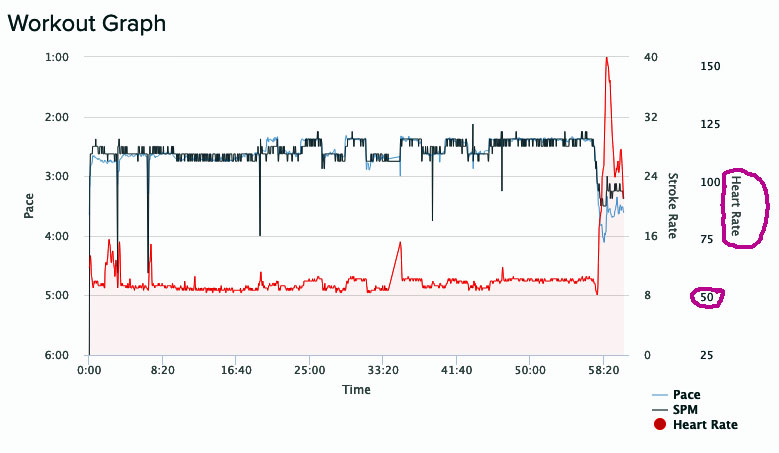
Every morning I check to see if HR is normal and what RHR (resting heart rate) was for the night before. Today it was normal and RHR was 51. But as I got ready for the rowing session this morning, heart rate felt a bit like it was on the brink of atrial fibrillation, with an occasional flippy sort of feeling.
So when I did the rowing session I decided to spend at least 20 minutes at a nice slow warmup pace before making any changes toward a faster pace. After about 20 minutes at a very easy effort level between 80 and 90 Watts, I started to feel the warming sensation that the warmup is named for, but heart rate stayed low in the 50 to 60 BPM range. I increased the pace and varied it a bit, going as high as around 120 Watts sometimes, but heart rate seemed to want to stay in the 50s and changed very little from that range. I decided to spend the rest of the rowing session with a low effort level between 80 and 120 Watts, which resulted in an average of about 89 Watts for the session. Heart rate remained very low for the entire time. Some of its behavior seemed to indicate that when I rowed a little harder, heart rate would slow down. I thought that if that were really the case and I wasn’t imagining it, then perhaps when I rowed a bit harder and the legs and other muscles were contracting a bit harder, those leg and other muscles were assisting to pump blood and therefore that would be why, with certain small increases in effort level, heart rate would slow down instead of increasing – because it was getting assistance from the pumping action of the contraction and relaxation of the other muscles during the rowing.
Heart rate remained in the 50s most of the time during this rowing session, except near the very end when I reduced rowing effort to such a very low level that the legs and other muscles were barely contracting at all and therefore virtually no assistance at all in pumping the blood – On the graph, that’s where you can see heart rate went the very highest… when it had to do most of the pumping of the blood with no assistance from other muscles. You can see in the chart of that session (below) how heart rate elevated the most when I slowed down to a barely perceptible effort level just before the end.

After that main rowing session of the morning, I decided to do a little experiment with a single short rowing session. During that session I deliberately changed rowing effort up and down and watched heart rate. You can see in several places on the graph of pace and heart rate, how a reduction in rowing effort was followed by an increase in heart rate and vice versa.

After all rowing was finished and while I effortlessly changed from rowing clothes to normal clothes, heart rate felt flippy and stayed that way with atrial fibrillation that lasted all day and is still persisting as this is being written.
Interesting.
Any workout sessions for any day can be seen in detail via this: link to the online logbook. To see a session’s data and interactive graph click the “+” sign in “Action” column for that session.
Happy rowing to you!
